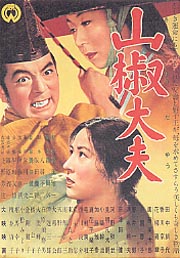- Sansho the Bailiff
Infobox Film
name = Sansho the Bailiff

image_size = 180px
caption =
director =Kenji Mizoguchi
producer =Masaichi Nagata
writer =Fuji Yahiro Yoshikata Yoda Ogai Mori (story)
narrator =
starring =Kinuyo Tanaka Yoshiaki Hanayagi Kyōko Kagawa Eitarō Shindō
music =
cinematography =Kazuo Miyagawa
editing =
distributor = Daiei
released =March 31 ,1954
runtime = 120 minutes
country =Japan
language = Japanese
budget =
gross =
preceded_by =
followed_by =
website =
amg_id = 1:42826
imdb_id = 0047445"Sansho the Bailiff" (Japanese: |山椒大夫|"Sanshō Dayū") is a 1954 film by Japanese
film director Kenji Mizoguchi . Based on a short story of the same name byMori Ogai , it tells the story of two aristocratic children sold into slavery. It is often considered one of Mizoguchi's finest films, along with "Ugetsu " and "The Life of Oharu ". It bears his trademark interest in freedom, poverty and woman's place in society, and features beautiful images and long and complicated shots. The director of photography for this film was Mizoguchi's regular collaboratorKazuo Miyagawa .ynopsis
"Sansho the Bailiff" is a "
jidai-geki ", or historical film, set in theHeian period offeudal Japan . A virtuous official is banished by a cruel governor to a far-off province. His wife and children are sent to live with her family, who several years later send them away. The wife and children then journey to his new posting, but are waylaid on the long journey. The children, brother and sister, are sold by slave traders to a manorial estate in which slave workers are brutalized as they work under horrific conditions and are punished when they try to escape. The estate is administrated by the eponymous Sansho, abailiff orsteward .The children, Anju and Zushio, grow up to maturity in the slave camp. Anju still believes in the teachings of her father, who advocated treating others with humanity, but Zushio has repressed his humanity, becoming one of the overseers who punishes other slaves, in the belief that this is the only way to survive. Meanwhile, his sister hears a song from another slave who was transferred from Sado Island mentioning them. This leads her to believe their mother’s still alive. She tries to convince Zushio to go and find their mother, but he refuses. When he is ordered to take Namiji, an older woman who has become a surrogate mother for them, out of the slave camp to be left to die from her own illness, he changes his mind and decides to escape to find his mother. Anju asks him to take Namiji with him, but decides to stay behind to distract the guards. Zushio promises to return for Anju after he finds their mother. However, Anju commits suicide so that she will not be forced to reveal where her brother is headed.
After Zushio escapes the slave camp, and finds his old mentor, Taro - Sansho’s son. Before Taro left Sansho, he had shown kindness to Zushio and Anju. By now, he has become a priest in the local imperial temple. Zushio asks Taro to take care of Namiji so Zushio can go to Kyoto to appeal to the Chief Advisor to the Emperor about the appalling conditions for the slaves. However, when Zushio then finds the Chief Advisor and begs him for help, he ignores Zushio until he finds out who he is. At that time, Zushio finds out that his father has passed away the previous year and so the Chief Advisor offers Zushio the same post as his father. As Governor of Tango Zushio orders an edict that forbids slavery both on public and private grounds. No one believes he can do this, since Governors have no command over private grounds; although Sansho offers initial resistance, Zushio orders him and his minions arrested, thus freeing the slaves. When he looks for Anju among Sansho's slave, he finds out his sister sacrificed herself for his freedom. His staff, now highly impressed with him, are shocked when he resigns, so that he can track down his mother. He finds her on a beach, a broken woman. At first she does not believe him, thinking he is just a trickster, but eventually he convinces her he is her son, and the film ends with their poignant restoration.
Responses
"Sansho" was the last of Mizoguchi's films to win an award at the
Venice Film Festival , which brought him to the attention of Western critics and film-makers. It is greatly revered by many critics; "The New Yorker " film criticAnthony Lane wrote in his September, 2006 profile on Mizoguchi, "I have seen "Sansho" only once, a decade ago, emerging from the cinema a broken man but calm in my conviction that I had never seen anything better; I have not dared watch it again, reluctant to ruin the spell, but also because the human heart was not designed to weather such an ordeal." ["The New Yorker " 2006, http://www.newyorker.com/critics/cinema/articles/060911crci_cinema?060911crci_cinema ]DVD
"Sansho" was unavailable on DVD in the
English-speaking world for many years, but in 2007, it was released inThe Criterion Collection inRegion 1 , whileMasters of Cinema released it inRegion 2 under the title "Sansho Dayu" in a double DVD twinpack with "Gion Bayashi ".Cast
Kinuyo Tanaka - TamakiKyoko Kagawa - AnjuEitaro Shindo - SanshoYoshiaki Hanayagi - ZushioIchiro Sugai - Minister of JusticeKen Mitsuda - Prime Minister Morozane FujiwaraMasahiko Tsugawa - Zushio as a BoyMasao Shimizu - Masauji TairaChieko Naniwa - UbatakeKikue Mori - PriestessAkitake Kono - TaroRyosuke Kagawa - Ritsushi KumotakeReferences
External links
* [http://www.eurekavideo.co.uk/moc/catalogue/sansho-dayu/ MoC Series page] and
QuickTime trailer
* [http://www.criterion.com/asp/release.asp?id=386&eid=535§ion=essay "The Lessons of" Sansho] essay by Mark Le Fanu
*
*
*
* " [http://www.jmdb.ne.jp/1954/cd000910.htm Sansho the Bailiff] " ja icon at theJapanese Movie Database
* [http://lejaponchezvous.blogspot.com/2007/06/19kenji-mizoguchi-lintendant-sansh-1954.html Two videos of "Sansho the Bailiff"]
Wikimedia Foundation. 2010.
